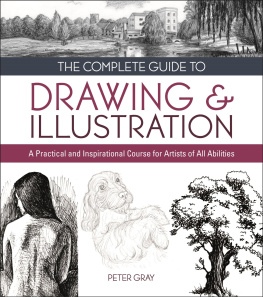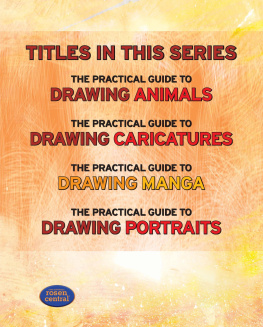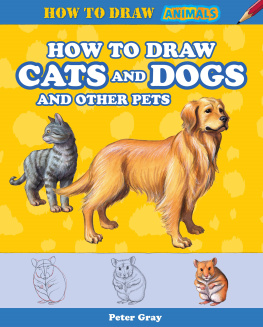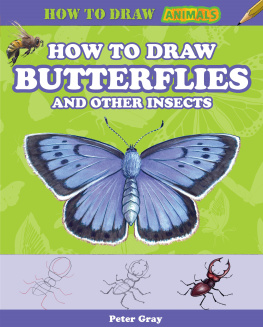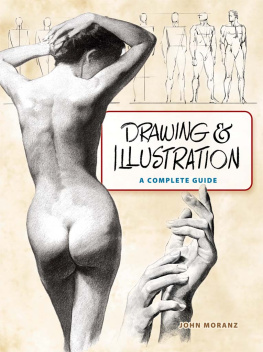
Dedicated to Mario Minichiello, Eric Luke, Robin Harris, and all my other fine tutors, who know a lot more about drawing than I do.
Introduction
I often hear people say, I wish I could draw. Perhaps you too have found yourself uttering those words. The response that immediately springs to my mind is Why dont you? Of all the pursuits open to us, drawing is perhaps the easiest to take up, requiring only minimal equipment: a pencil and some blank paper.
The fact is that nearly everyone draws already. Who has not sketched a rough map to give directions, or made doodles on a telephone message pad? In these activities are two of the essential elements of drawing: selection and simplification, and uninhibited mark making. The third element is observation. In ordinary life, people see what they have already learnt is likely to be there, but through the process of drawing, we overcome our expectations and notice subtleties of shape and structure, texture and pattern, light and shade. We develop sight into insight.
Drawing is a form of art, and art does not recognize boundaries or fit into neat pigeonholes. However, to make this vast and varied activity approachable, this book is divided into broad areas of subject matter. From simple object drawing we move on to tackle all aspects of our environment, people and animals. A certain amount of art theory will necessarily be introduced along the way, but Ive tried to keep this to a minimum and explain things, wherever possible, through practical demonstrations.
The book is designed as a course, with each new subject following naturally from the previous one. To get the most out of it, work your way through from page one. Suitable for complete beginners, as well as those who have some experience, the book opens with the most elementary drawing exercises. You may be inclined to find you own way through the book and skip to subjects and techniques that suit your interests. With this in mind, a comprehensive index should allow you to check back to previous exercises and pick up any information you may have missed.
There is so much more to drawing than acquiring the facility to copy from a picture or object. It is also about developing your own subjects and compositions and finding individual means of expression. Unlike many other drawing manuals, this book aims to direct you towards imaginative end results, introducing in each subject area ideas for developing your sketches into various forms of illustration and design. When following the step-by-step exercises, try to resist simply copying mine. Find similar subjects of your own and work through the stages, to create new pictures rather than mere copies.
I hope to debunk some of the myths that persist around the practices and processes of drawing. It is true that some people are born with exceptional gifts, but these are rare and most artists achieve their proficiency through fascination and sheer persistence. You may look at an artists drawings and think that they were produced effortlessly, but thats what they want you to think. Behind every successful drawing lie a great deal of thought, application and a history of mistakes and false starts. Even the most advanced draughtsman will always see their faults and strive for improvement. In that light, an accomplished artists drawings are no different from your own faltering first steps; all are mere stages on a journey that has no end. Interesting discoveries await at every turn. The going may sometimes be arduous, but there will also be times when things click into place and you surge ahead. Above all, drawing should never be boring, so if you find a subject tedious, accept that its not for you at that time, and move on. The best way to stay the course is to enjoy yourself. Like so much of life, what you get out of drawing is dependent on what you put in. It is an activity that calls for dedication, experimentation and play, and rewards you with self-satisfaction and a heightened appreciation of the world around you.
Peter Gray
THE FIRST MARKS
Before a drawing begins, the artist opens his or her sketchbook, chooses and sharpens a pencil, and then there comes a brief moment of anticipation, excitement and even fear. It takes something like courage to make the first mark on the virgin paper, but once that mark is made, the others come flowing.
This chapter deals with the first marks you make coming to the activity as a complete novice and aims to steer you around some of the mental stumbling blocks that could be awaiting you. From the very start you should aim to draw with confidence and expression, even at the expense of precision. Some very simple exercises should limber you up and get you comfortable with holding a pencil and pushing it about on the paper.
If you have some experience of drawing, much of the information contained within this short chapter will probably be familiar to you already. Whatever level you feel you are at, it never does any harm to be reminded of the basics, so I urge you to at least read the early pages, even if you choose to give the exercises a miss.

Basic materials and equipment
One of the great things about taking up drawing is that you need very little equipment to get started. There is a large and highly profitable industry in artists materials and some of the elaborate items on show in art shops can be very tempting, but fancy media and equipment generally do little to improve skills and can confuse the issue of learning to draw. To start with youll need pencils, paper, an eraser and a knife, but throughout the book well look at other materials and tools you might want to experiment with and add to your kit.

Pencils
Although any pencil will do for mastering the basics of drawing, cheap ones can be scratchy and unsatisfying to work with. Its well worth splashing out on a few good-quality pencils from an art supplies shop. They are graded from H (hard) to B (black) with a number prefix indicating the degree of hardness or blackness. A useful starting set would be H, HB, 2B and 6B.
Eraser
An eraser is a vital part of your kit. Theres absolutely no shame in erasing mistakes and rough guidelines they are an important part of the drawing process. Buy a good-quality eraser that is neither too hard nor too spongy; there are dozens of varieties on the market, but they all do essentially the same job. When the corners wear blunt, an eraser can be trimmed with a knife to produce a fine working edge. For fiddly erasing I often use a special eraser that comes in the form of a pencil and can be sharpened to a point.
Paper
At this stage, virtually any paper will do the job. A cheap A4 sketchpad would be good, but photocopy paper or even scrap paper will do fine. (If youre not using a pad, youll need to find a piece of board a little larger than your paper to lean on.) The more your skills develop the more important the grade and type of paper will become, but at the novice stage expensive paper only serves to inhibit your freedom to make mistakes.
Sharpening
A sharp knife or scalpel is essential for fashioning the points of your pencils. For drawing, pencils are ideally sharpened to reveal a good length of lead, unlike the uniform point produced by a pencil sharpener. Keep the blade at an acute angle to the pencil, and always sharpen the pencil away from your body.
Next page
